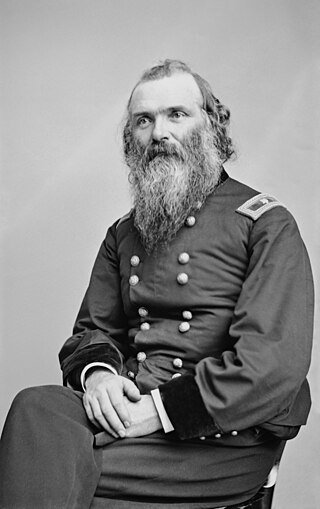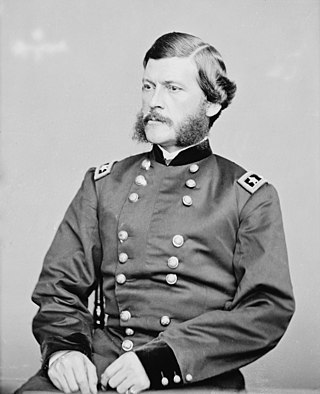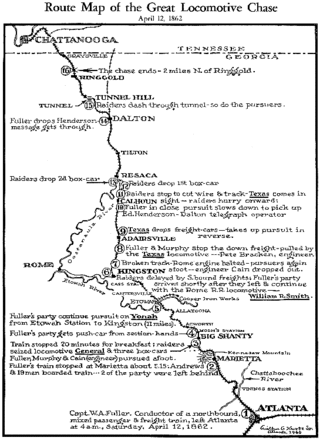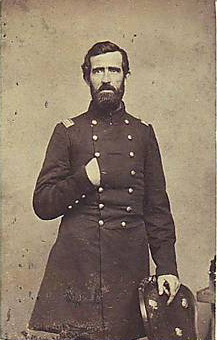
Sherman's March to the Sea was a military campaign of the American Civil War conducted through Georgia from November 15 until December 21, 1864, by William Tecumseh Sherman, major general of the Union Army. The campaign began on November 15 with Sherman's troops leaving Atlanta, recently taken by Union forces, and ended with the capture of the port of Savannah on December 21. His forces followed a "scorched earth" policy, destroying military targets as well as industry, infrastructure, and civilian property, disrupting the Confederacy's economy and transportation networks. The operation debilitated the Confederacy and helped lead to its eventual surrender. Sherman's decision to operate deep within enemy territory without supply lines was unusual for its time, and the campaign is regarded by some historians as an early example of modern warfare or total war.

Daniel Craig McCallum was a Scottish-born American railroad engineer, general manager of the New York and Erie Railroad and Union Brevet Major General of the United States Military Railroads during the American Civil War, known as one of the early pioneers of management. He set down a group of general principles of management, and is credited for having developed the first modern organizational chart.

The Atlanta campaign was a series of battles fought in the Western Theater of the American Civil War throughout northwest Georgia and the area around Atlanta during the summer of 1864. Union Maj. Gen. William Tecumseh Sherman invaded Georgia from the vicinity of Chattanooga, Tennessee, beginning in May 1864, opposed by the Confederate general Joseph E. Johnston.

John Grubb Parke was a United States Army engineer and a Union general in the American Civil War. Parke's Civil War service was closely associated with Ambrose E. Burnside, often serving him as chief of staff in major engagements such as Antietam, Fredericksburg and the Overland Campaign. Parke also held significant field commands during Burnside's North Carolina Expedition, Vicksburg and the battle of Fort Stedman as well as brief stints in command of the Army of the Potomac.

The Western & Atlantic Railroad of the State of Georgia (W&A) is a railroad owned by the State of Georgia and currently leased by CSX, which CSX operates in the Southeastern United States from Atlanta, Georgia, to Chattanooga, Tennessee.

Sherman's neckties were a railway-destruction tactic used in the American Civil War. Named after Maj. Gen. William Tecumseh Sherman of the Union Army, Sherman's neckties were railway rails destroyed by heating them until they were malleable and twisting them into loops resembling neckties, often around trees. Since the Confederacy had limited supplies of iron, and few foundries to roll the rails, this destruction was very difficult to repair. They were also called Sherman's Bowties, Jeff Davis's Neckties, and Sherman's hairpins.

Sope Creek is an 11.6-mile-long (18.7 km) stream located in Cobb County, Georgia, United States. It is a significant tributary of the Chattahoochee River. It was known as Soap Creek during the 19th century. A section of Sope Creek runs through the Chattahoochee River National Recreation Area.

Herman Haupt was an American civil engineer and railroad construction engineer and executive. As a Union Army General during the American Civil War, he revolutionized U.S. military transportation, particularly the use of railroads.

Thomas Welsh was a soldier in the United States Army during the Mexican–American War and a Union brigadier general during the American Civil War.

The city of Atlanta, Georgia, in Fulton County, was an important rail and commercial center during the American Civil War. Although relatively small in population, the city became a critical point of contention during the Atlanta Campaign in 1864 when a powerful Union Army approached from Union-held Tennessee. The fall of Atlanta was a critical point in the Civil War, giving the North more confidence, and leading to the re-election of President Abraham Lincoln and the eventual dissolution of the Confederacy. The capture of the "Gate City of the South" was especially important for Lincoln as he was in a contentious election campaign against the Democratic opponent George B. McClellan.

The U.S. Military Railroad (USMRR) was established by the United States War Department as a separate agency to operate any rail lines seized by the government during the American Civil War. An Act of Congress of 31 January 1862 authorized President Abraham Lincoln to seize control of the railroads and telegraph for military use in January 1862. In practice, however, the USMRR restricted its authority to Southern rail lines captured in the course of the war. As a separate organization for rail transportation the USMRR is one of the predecessors of the modern United States Army Transportation Corps.

The Potomac Creek Bridge was first built in 1842 by the Richmond, Fredericksburg and Potomac Railroad across the Potomac Creek in Stafford County, Virginia, United States.
The 55th Ohio Infantry Regiment was an infantry regiment in the Union Army during the American Civil War.

The Tapeworm Railroad was a railway line planned by Congressman Thaddeus Stevens and nicknamed by opponents ridiculing a lengthy serpentine section around the Green Ridge of South Mountain after an orator compared the path to a tapeworm depiction on a product's packaging. Switchbacks were planned on the west slope at Hughs Forge along the E Br Antietam Creek and on the east slope at Stevens' 1822 Maria Furnace along Toms Creek, with 3 east slope tunnels through spurs of Jacks Mountain.

The 56th Pennsylvania Volunteer Infantry was an infantry regiment that served in the Union Army during the American Civil War. The unit has the distinction of being the first Union Army infantry regiment to open fire at the Battle of Gettysburg.

The 111th Pennsylvania Volunteer Infantry was an infantry regiment that served in the Union Army during the American Civil War. It was noted for its holding the high ground at the center of the line at Antietam as part of Stainrook's 2nd Brigade, Greene's 2nd Division of Mansfield's XII Corps.

William Wierman Wright was a well known nineteenth century American railroad engineer and civil engineer. He was born in York Springs, Pennsylvania.

Rousseau's Opelika Raid saw 2,700 Union cavalry led by Major General Lovell Rousseau raid deep into Alabama in the Atlanta Campaign during the American Civil War. The successful raid began at Decatur, Alabama, and was only opposed by minimal forces of the Confederate States Army. The Union raiders rode south-southeast across the state destroying Confederate supplies and public property. They wrecked as much as 30 mi (48.3 km) of the Montgomery and West Point Railroad near Opelika, Alabama. The Union cavalry then turned northeast and joined the army of Major General William Tecumseh Sherman near Marietta, Georgia, while sustaining few casualties.

The 50th New York Engineer Regiment was an engineer regiment that served in the Union Army during the American Civil War. The regiment was initially raised as the 50th Volunteer Infantry, but was converted to an engineer regiment after it arrived in Washington DC. It served as an engineer unit for the Army of the Potomac (AoP) from the Peninsula Campaign through the Appomattox Campaign.





















